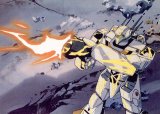

Quick Links:
Robotech: The Macross Saga
Robotech is simply unique. Historically, this series, more than any other, began the mass market anime craze in the U.S. Robotech is actually the compilation of three diverse Japanese series, edited together with a totally new storyline by Carl Macek. The resulting storyline has a huge, epic scope and holds together rather well for having such diverse source material.
This review covers the first DVD box set of the Macross Saga - the first of the three chapters in the Robotech series. The set includes the first 12 episodes plus a supplemental DVD. For the purposes of this review, the Robotech Macross Saga will be judged independently of the original Japanese series, Superdimensional Fortress Macross. For purists, Animeigo is planning the release of the entire original Japanese Macross series on DVD.
The story of Robotech begins when an alien spacecraft of immense size and superior technology crashlands on a small Pacific island. The shockwaves from the craft reverberate around the world, literally and figuratively. Several cities are destroyed as the craft passes through the atmosphere, and the nations of the world cease their current wars, noting that a power beyond their imagination has just arrived. The world focuses all of its resources of rebuilding the ship and understanding the secrets hidden within. Ten years later, the newly christened SDF-1 is ready to launch.
But, surrounding the ship, a thriving city has grown up -- Macross City. The entire city turns out to watch the launch celebrations. Rick Hunter, a young air circus pilot, arrives on the scene to see his “big brother,” Roy Fokker, take off in the spaceship. Fokker is truly a big brother figure to Hunter; Rick grew up while Fokker worked for his father’s air circus. Rick interrupts a flight demonstration narrated by Fokker, much to the delight of the crowd, including a young beauty named Lynn Minmei. Meanwhile, Captain Gloval, the man who will lead the SDF-1, is just arriving on the SDF-1, his dour disposition giving away his belief that the launch is premature. On bridge, Lisa Hayes and Claudia Grant prepare the ship for its upcoming departure.
The introductions take up less than the first half of the first show. Now it’s time for action! The aliens show up and want the ship back. The humans blunder their way through the first encounters with equal doses of luck and determination, coupled with a bit of inspiration, keeping them out of the enemies’ hands. Without ruining too much, the ship ends up near the orbit of Pluto and must make a six-month journey home. For an ensemble show, this first part of Robotech is incredibly effective at introducing the cast.
The writing, when one takes into account when it was written and who it was shown to, is excellent and revolutionary. This isn’t to say that every line compares favorably to Shakespeare; rather, the storyline simply doesn’t stoop to the lowest common denominator. People will be able to enjoy the transforming robots and great action, but others will truly enjoy the interpersonal relationships and the comments on our culture that show delves into. Other than the sometimes inane recap before every episode (obviously the producers believed their main audience would be suffering from Alzheimer’s) the show never really caters to the “cartoons are for kids” mentality subscribed to by most animated series of the 80’s, or even the 90’s for that matter.
For someone to call the show revolutionary, there must be some significant support. First, the show was a serial: relationships developed, grew, fell apart; the war continued linearly from episode to episode. This really had never been done so successfully in the U.S., even though there had been some attempts. Second, people died. Important people, little kids, soldiers, civilians - in Robotech, as in life, war doesn’t care who it engulfs in its flames. A risky move, but it pays off in spades in the emotional attachment you feel for the ship and crew, something nearly unknown at the time and somewhat rare in broadcast animation today. Third, the relationships were real. The series starts off with an interracial relationship between Roy Fokker and Claudia Grant, soldiers imply that Rick and Minmei were physically involved (even though they weren’t), and so on. Contrast this with other cartoons of the time - usually, if you saw someone date someone in a cartoon, they’d turn out to be a villain or not be able to handle the hero’s lifestyle; one way or another, they would be gone in one episode, preventing any lasting relationships. And finally, the show is courageous enough to show conflict between humans themselves in all forms. Pacifists argue with the military, the government struggles with doing the right thing, good people do bad things out of jealousy. How often do you see a persuasive argument supporting the need for the military, while at the same time seeing just as strong an argument for disarmament? Such serious debates are commonplace in Robotech.
The story is strong, but how is the animation? The simple answer - it depends. The most obvious fact is that there were several animation teams working on the series; unfortunately, one or two of the teams was significantly better than the others. You’ll see a phenomenal episode, comparing favorably with more recent shows like Gundam Wing - then, in the next show, the characters look like incomplete zombie drawings. Robotech does have some of the best mecha combat scenes around; unfortunately, the quality on these can be uneven as well. On the other hand, the character designs by Haruhiko Mikimoto are fantastic and very unique; once you watch the Macross Saga, you’ll be able to spot the characters in a heartbeat.
The video transfer is nothing to write home about. Scratches and smudges are readily apparent. There was only one source for the series because of the way it was been edited together and dubbed. So, the sound and video pretty much the way they are for good. In other words, don’t expect leaps and bounds over the old VHS tapes. The only real difference is that the DVDs don’t degrade with each use.
The mecha designs by Shoji Kawamori are his inspired best, mainly because of the simplicity of design. He’s done fantastic work on many series and games since, including his wonderful Escaflowne series and movie, but seeing the Valkyries fight is still phenomenal. Kawamori himself remarks that out of all his work, he feels the most satisfaction in this design. The Valkyrie looks like an F-14, but transforms into a robot in a fascinating process. A hybrid mode can also be created that allows for great mobility in urban environments. [Note: they make great toys! Check out our news story on the new release of the VF-1 series in Japan; NCS is taking pre-orders.]
The music borders between inspired and tepid, however it does work. The Robotech anthem that plays over the opening is fantastic and more than memorable, as are some of the different fighting tracks. Sit down in a flight combat simulator in an arcade sometime and try to keep the music out of your head. The music captures emotional moods surprisingly well, even though a majority of it is synth work. You’ll immediately begin to move into the emotional state that the story expects when certain tracks are played. In general, the music stays in the background but keys the story at the proper time.
As far as the voice acting goes, the majority of the main characters are rather well done, and they settle into the roles much better as the series continues. On the other hand, some of the minor characters, including some recurring characters, are just plain bad. They go overboard.
As far as value you goes, the box set is an excellent deal. The two primary DVD’s carry episodes each, carrying the Macross arc through the first third of 36 epidodes. The supplemental disc includes Codename: Robotech, a composite of the Macross episodes put together to sell the series to U.S. TV stations and bring people into the series. It was shown as an “event” piece on most stations before the series began and had never been released to the general public previously. This also includes an audio track by Carl Macek, the force behind creating Robotech, production sketches, and international clips. The box for the set is actually rather nice and stylish, as well. The DVD covers use excellent Japanese promotional art and scenes direct for the series - no rip-off art here.
I highly recommend this series to all fans of animation. The story is excellent and fun - you’ll get a laugh here and a tear there (yes, there are some very sad scenes). However, if you look for DVDs to showcase your home theater system, this isn’t the series to choose. A marginal transfer and the unavoidable fact that this is an early 80’s TV show keep it from being a technical marvel. Overall, it is an exciting adventure for those who can escape the purist tendencies of the hardcore anime fan.
Distributor: ADV Creator: Carl Macek / Harmony Gold Released: 1985
Video Quality: C Audio Quality: B Presentation: A+ Content: A Overall: B+



